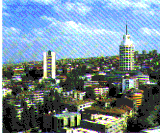ANKARA : THE CAPITAL OUT OF
STEPPE
The city of Ankara lies in the center of Anatolia on the eastern edge
of the great, high Anatolian Plateau, at an altitude of 850 meters. It
is the center of the province of the same name, which Is a predominantly
fertile wheat steppeland with forested areas in its northeast region. It
is bordered by the provinces of Cankiri and Bolu to the north, Eskisehir
to the west, Konya and Aksaray to the south, and Kirikkale and Kirsehir
to the east.
 The region's history goes back to the Bronze Age, Hatti Civilization,
which was succeeded in the 2nd millennium BC by the Hittites, then the
Phrygians (10th century BC); Lydians and Persians followed. After these
came the Galatians, a Celtic race who were the first to make Ankara their
capital (3rd century BC). It was then known as Ancyra, meaning anchor.
The town subsequently fell to the Romans, Byzantines, and Selcuks under
Alpaslan in 1073, and then to the Ottomans under Yildirim Beyazit in
1402, who remained in control until the First World War.
The region's history goes back to the Bronze Age, Hatti Civilization,
which was succeeded in the 2nd millennium BC by the Hittites, then the
Phrygians (10th century BC); Lydians and Persians followed. After these
came the Galatians, a Celtic race who were the first to make Ankara their
capital (3rd century BC). It was then known as Ancyra, meaning anchor.
The town subsequently fell to the Romans, Byzantines, and Selcuks under
Alpaslan in 1073, and then to the Ottomans under Yildirim Beyazit in
1402, who remained in control until the First World War.
The town, once an important trading center on the caravan route to the
east, had declined in importance by the nineteenth century. It became an
important center again when Kemal Atatürk chose it as the base from
which
to direct the War of Liberation. In consequence of its role in the war
and its strategic position, it was declared the capital of the new
Turkish Republic on the 13th October,1923.
TRAVEL
To reach Ankara is not difficult. Most countries have flights to the
city's Esenboga Airport, and from this airport there are regular flights
to the major cities of Turkey. Ankara is the center of Turkey's excellent
and very extensive coach network; and it is possible to travel to and
from the city to most Turkish towns and cities, and many major European
cities. Turkish railways offer a more leisurely mode of travel to a
number of cities.
CLIMATE
The climate is a typical continental one. The summers are long and
pleasantly hot, with cool nights; there is little rainfall or humidity.
The winters are cold with some rain and snow.
AVERAGE TEMPERATURES IN C
Jan Feb Mar Apr May Jun Jul Aug Sep Oct Nov Dec
-1 1 5 11 16 20 23 23 18 13 8 2
Source: Ministry of Tourism, Republic of Turkey
Return to home page
Send your comments to:
 Melih
Özbek
Melih
Özbek
melih@knidos.cc.metu.edu.tr
 The region's history goes back to the Bronze Age, Hatti Civilization,
which was succeeded in the 2nd millennium BC by the Hittites, then the
Phrygians (10th century BC); Lydians and Persians followed. After these
came the Galatians, a Celtic race who were the first to make Ankara their
capital (3rd century BC). It was then known as Ancyra, meaning anchor.
The town subsequently fell to the Romans, Byzantines, and Selcuks under
Alpaslan in 1073, and then to the Ottomans under Yildirim Beyazit in
1402, who remained in control until the First World War.
The region's history goes back to the Bronze Age, Hatti Civilization,
which was succeeded in the 2nd millennium BC by the Hittites, then the
Phrygians (10th century BC); Lydians and Persians followed. After these
came the Galatians, a Celtic race who were the first to make Ankara their
capital (3rd century BC). It was then known as Ancyra, meaning anchor.
The town subsequently fell to the Romans, Byzantines, and Selcuks under
Alpaslan in 1073, and then to the Ottomans under Yildirim Beyazit in
1402, who remained in control until the First World War. Melih
Özbek
Melih
Özbek